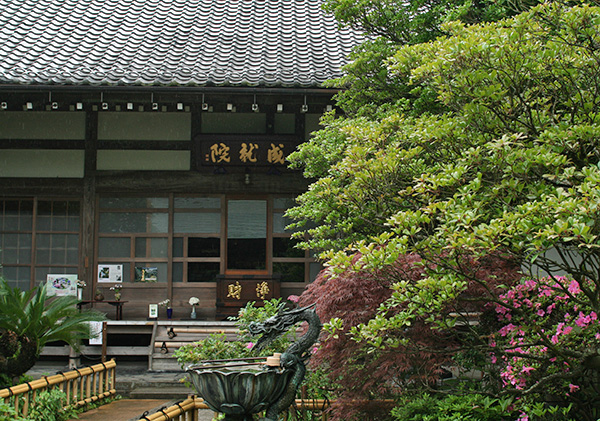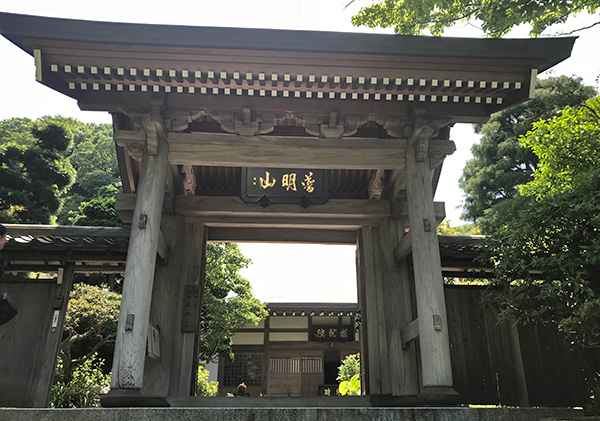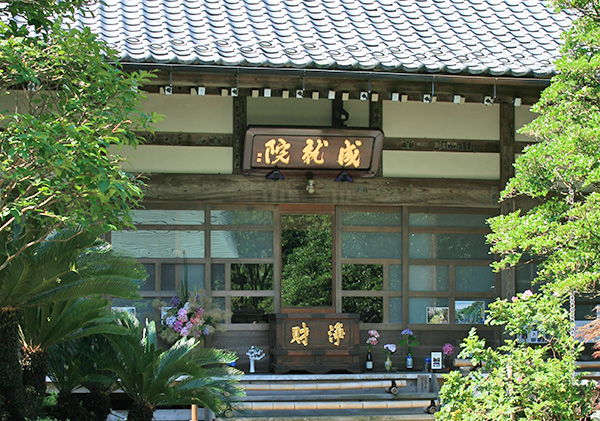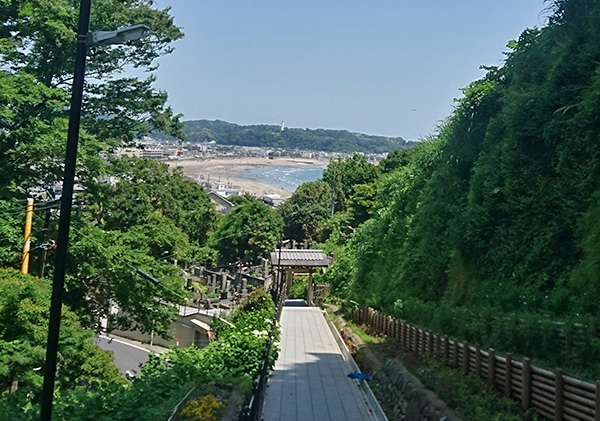Joju-in
| Official Name | Fumyozan Horyuji Joju-in {Pronounced foo-myo-zan hoh-ryu-gee joe-jew-in} |
|---|---|
| Religious sect | Shingon sect, Buddhism |
| Founded | in 1219 by Yasutoki Hojo {yah-soo-toh-key hoh-joe} |
| Founding priest | Unknown |
| Main object of worship | Statue of Fudo Myo-o {foo-doh myo-oh} or Acala-vidyaraja in Sanskrit |
| Address | 1-5 Gokurakuji 1-chome, Kamakura, Kanagawa 248-0023 (show route from current location ) |
| Location | 2,200 meters west southwest of Kamakura Station |
| Time needed to get there | 40 minutes |
| Admission | Free |
| Open | April-October: 8:00-17:00 November to March: 8:00-16:30 |
| Phone number | 0467-22-3401 |
| Restrooms | Not available |
Historical Overview
Legend has it that Yasutoki Hojo (1183-1242) built the Temple in 1219 to pray for the Hojos' good luck in war at the site where Priest Kukai {koo-kye} (774-835), the founder of Shingon sect Buddhism, had held a sacred fire-ritual for invocation while he was travelling in this region. The ritual is called Goma {goh-mah} in Japanese or Homa in Skt., meaning a holy fire for invocation to exorcise evil spirits, practiced mostly by esoteric Buddhists of such as Shingon sect. To be specific, it is the rite of burning cedar sticks on the altar while chanting sutras and using many Buddhist fittings. Fire is believed to purify or ward off the evil spirits. In general, ritualism of this sect is very elaborate and complicated.
But, the founding priest is unknown. The principal object of worship is Fudo Myo-o or the Immovable as the Japanese call it.
Also enshrined statue is that of Mongaku {mon-gak} (1139-1203), a famous priest for the Shingon sect, well known as he was in austere training in the early Kamakura Period (1185-1333) and erected Fudarakuji. Priest Mongaku committed homicide by accident when he was serving as a samurai for the Imperial Court in Kyoto. Knowing he killed someone else's wife, he immediately took Buddhist vows. Later, he was exiled to Izu as a criminal, where he got acquainted with Yoritomo Minamoto, the founder of Kamakura Shogunate, and persuaded him to fight against the Taira clan.
The Temple flourished as long as the Hojo family was in power. However, it was completely destroyed when the loyalist troops led by Yoshisada Nitta {yo-she-sah-dah nit'-tah} (1302-1338) attacked Kamakura in 1333 as this area became a fierce battleground. Fortunately, the statues had been carried out and kept at a small retreat located in a hill behind Gokurakuji before the war broke out. After the Temple was rebuilt here during the Edo Period (1603-1868), the statues were relocated as well.
Other than Fudo Myo-o, the following statues are also enthroned on the alter of the main hall:
Thousand-Armed Kan'non or Sahasrabhuja in Skt.
Sho-Kan'non or Arya-avalokitesvara in Skt., This statue ranks 21st of the Thirty-Three Kamakura Kan'non Pilgrimage.
Jizo Bosatsu or Ksitigarbha-bodhisattva in Skt.
Priest Kukai, fashioned in the mid-Edo Period.
Unfortunately, inside the hall is too dark and the statues can barely be made out in the dim natural light. In addition, reflection of glass pane does not allow us to peer in. To worship and watch those statues, advance reservations are necessary.
In the courtyard, there are two bronze statues: Those of Fudo Myo-o and Priest Kukai in mendicancy.
The approach to the Temple has a flight of 108 steps and both sides are lined with hydrangeas. From mid-June through early July, beautiful flowers are in full bloom and the Temple is called "Another Ajisai (hydrangea) Temple". (The other one is Meigetsu-in). As the steps show, the Temple is located on the top of a hill and the step-path was the only road available back in the Kamakura Period. (The car-running road down the Temple was built only recently in the 1910s.) It was an open-cut made by Priest Ninsho (1217-1303), the founding priest of the neighboring Gokurakuji and an important road leading to Inamuragasaki {e-nah-moo-rah-gah-sah-key} seashore.
The open-cut was the main road back at the time used for going to and coming from Kyoto. As one of the ancient Seven Open-cuts in Kamakura, it was strategically developed to defend enemy attacks. In other words, the open-cut path was just wide enough for a horse to go through. When Yoshisada Nitta attacked Kamakura, the path was so impregnable that the troops with tens of thousands samurai gave up passing this road after four-time unsuccessful attacks. His troops finally retreated to the Inamuragasaki coast and retried attack from the promontory there. His breakthrough operation succeeded and eventually led to the falldown of the Kamakura Shogunate.
Today's landscape does not tell us anything about the bitter battle but, human skeletons, bones, and broken weapons were quite often unearthed around here.
Down the road, or 150 meters east of Joju-in to be exact, is a small temple called Kokuzo-do {ko-koo-zoe-doh}, which is part of Jojuin and under its management. Kokuzo is Akasagarbha in Skt., and worshiped among the Shingon sect Buddhists.





